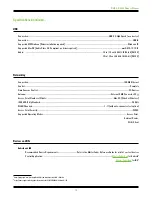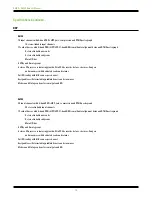
DL16S • DL32S Owner’s Manual
29
Glossary Of Terms Continued...
Pre DSP
— Pre DSP is ideal when using the auxes for monitor mixes and you want compression and other effects in the main mix,
but not the monitors. Pre DSP is available in all auxes, but not the FX.
Pre Fader
— A term used to describe an aux send (or other output) that is connected so that it is not affected by the setting
of the associated channel fader. Sends connected this way are typically (but not always) used for monitors.
Q
— A way of stating the bandwidth of a filter or equalizer section. An EQ with a Q of .75 is broad and smooth, while a Q of 10
gives a narrow, pointed response curve. To calculate the value of Q, you must know the center frequency of the EQ section
and the frequencies at which the upper and lower skirts fall 3 dB below the level of the center frequency. Q equals the center
frequency divided by the difference between the upper and lower 3 dB-down frequencies. A peaking EQ centered at 10 kHz
whose –3 dB points are 7.5 kHz and 12.5 kHz has a Q of 2.
Reverberation, Reverb
— The sound remaining in a room after the source of sound is stopped. It’s what you hear in a large tiled
room immediately after you’ve clapped your hands.
Reverberation and echo are terms that are often used interchangeably, but in audio parlance, a distinction is usually made:
reverberation is considered to be a diffuse, continuously smooth decay of sound, whereas echo is one or more distinct,
recognizable repetitions of a word, note, phrase or sound which decreases in amplitude with every repeat.
Highly reverberant rooms are called live; rooms with very little reverberation are called dead. A sound source without added
reverb is dry; one with reverb added is wet.
RFI
— Radio Frequency Interference. High frequency radiation that often results from sparking circuits. This may be manifested
in a number of ways in audio systems, but is usually evident as a high-frequency buzz or harsh sound.
RMS
— An acronym for root mean square, a conventional way to measure the effective average value of an audio signal
or other AC voltage. Most AC voltmeters are calibrated to read RMS volts, though on many meters that calibration
is accurate only if the waveform is sinusoidal.
Sampling Frequency
— This is the rate at which an analog signal is sampled during the analog-to-digital conversion process.
The sampling rate used for CDs is 44.1 kHz, but professional recordings are often sampled at higher sample rates.
Send
— A term used to describe the output of a secondary mix of the input signals, typically used for monitors, headphone amp
or effects devices. These are the aux sends on the DL Series mixers.
Shelving
— A term used to describe the shape of an equalizer’s frequency response. A shelving equalizer’s response begins
to rise (or fall) at some frequency and continues to rise (or fall) until it reaches the shelf frequency, at which point the
response curve flattens out and remains flat to the limits of audibility. If you were to graph the response, it would look like
a shelf. Or more like a shelf than a hiking boot. See also peaking and dipping.
Signal-to-Noise (S/N)
— This is a specification that describes how much noise an audio component has compared to the signal.
It is usually expressed in dB below a given output level. The S/N of the DL Series mixers is 92 dB.
Solo
— Italian for alone. Solo allows you to listen to individual channels singly or in combination with other soloed signals.
Sound Reinforcement
— A system of amplifying acoustic and electronic sounds from a performance or speech so that a large
audience can hear clearly. Or, in popular music, so that a (hopefully) large audience can be excited, stunned, or even partially
deafened by the tremendous amplification. Sound reinforcement means essentially the same thing as PA [Public Address].
Spaghetti
— That mess of wires and cables in the back of your rack and/or console. You really can tame this beast.
SR
— An acronym for Sound Reinforcement, which refers to the process (or a system for) amplifying acoustic and electronic
sounds from a performance or speech so that a large audience can hear clearly. Or, in popular music, so that a (hopefully)
large audience can be excited, stunned, or even partially deafened by the tremendous amplification. Sound reinforcement
means essentially the same thing as PA [Public Address].
Содержание DL16S
Страница 1: ...OWNER S MANUAL ...




































